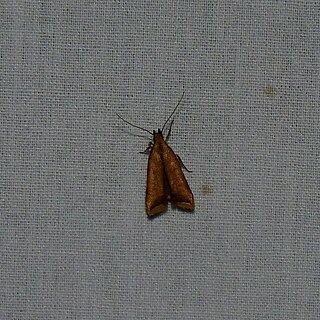
The Gelechiidae are a family of moths commonly referred to as twirler moths or gelechiid moths. They are the namesake family of the huge and little-studied superfamily Gelechioidea, and the family's taxonomy has been subject to considerable dispute. These are generally very small moths with narrow, fringed wings. The larvae of most species feed internally on various parts of their host plants, sometimes causing galls. Douglas-fir (Pseudotsuga) is a host plant common to many species of the family, particularly of the genus Chionodes, which as a result is more diverse in North America than usual for Gelechioidea.

Apatetris is a genus of moths in the family Gelechiidae.
Faristenia is a genus of moths in the family Gelechiidae.

Monochroa is a genus of moths in the family Gelechiidae.

The Angoumois grain moth is a species of the Gelechiidae moth family, commonly referred to as the "rice grain moth". It is most abundant in the temperate or tropical climates of India, China, South Africa, Indonesia, Malaysia, Japan, Egypt and Nigeria, with its location of origin being currently unknown. It is most commonly associated as a pest of field and stored cereal grains as they burrow within the kernel grains of crop plants, rendering them unusable for human consumption. By laying eggs between the grains themselves and hatching at a later time, often during the processing, transportation or storage stages, the moth can be transported to households or countries presently free of Angoumois grain moth infestations. Thus, constant protection against the Angoumois grain moth is required for grain up till the time of consumption.
Dichomeris acuminata, the alfalfa leaf tier, is a moth of the family Gelechiidae. It was first described by Otto Staudinger in 1876. It is a widely distributed species, being known from India, Myanmar, and Sri Lanka southwest to the Seychelles, Mauritius and Réunion and on to Egypt, east and South Africa and southern Europe. Eastward from India it extends through Indonesia and Malaysia to Taiwan and Australia. It is also found in Japan, the West Indies, North America and Hawaii.

The black-edged dichomeris or black-edged carbatina is a moth of the family Gelechiidae. It is found in the north-eastern United States, Korea, Japan, China, Taiwan and India. It has also been recorded in the Netherlands, where it is an exotic species.

Dichomeridinae is a subfamily of moths in the family Gelechiidae.

Argolamprotes micella, the bright neb, is a moth of the family Gelechiidae. It is found in most of Europe, except Ireland, the Iberian Peninsula and most of the Balkan Peninsula. Outside of Europe, it is known from Siberia, the Russian Far East, the southern Kuril Islands and Japan. The habitat consists of hedgerows, open woodland and gardens.
Anarsia protensa is a moth of the family Gelechiidae. It was described by Kyu-Tek Park in 1995. It is found in Japan and Taiwan.

Chionodes continuella is a moth of the family Gelechiidae. It is found from most of Europe, east to Japan. It is also present in most of North America.
Monochroa conspersella is a moth of the family Gelechiidae. In Europe, it is found from the Alps to the north. In the east, the range extends to the southern Ural and the Middle Volga, as well as Japan.

Monochroa divisella, the scarce marsh neb, is a moth of the family Gelechiidae. It is found in Denmark, Latvia, Germany, the Netherlands, Belgium, Great Britain, the Czech Republic, Hungary, Bulgaria and France. Outside of Europe, it is known from Korea, the Russian Far East and Japan. The habitat consists of fens, marshes, river-banks and other damp areas.
Psoricoptera speciosella is a moth of the family Gelechiidae first described by Karl August Teich in 1892. It is found from northern and central Europe south to France, northern Italy and Romania. It is also found in the European part of Russia, Siberia, the Russian Far East and Japan.

Psoricoptera gibbosella, the humped crest, is a moth of the family Gelechiidae. It is widely distributed in Europe. Outside of Europe, it is found in Turkey, North Africa, China, Japan, Korea, Siberia and the Russian Far East. The habitat consists of mature woodlands.

Scrobipalpa atriplicella, the goosefoot groundling moth, is a moth of the family Gelechiidae. It is found from most of Europe throughout Asia to Kamchatka and Japan. It is an introduced species in North America.
Scrobipalpa rebeli is a moth of the family Gelechiidae. It is found in Austria, Italy, Ukraine and the Krasnoyarsk region in southern Siberia. It is also present in China (Shaanxi) and Japan.

Eulamprotes atrella, the two-spotted neb, is a moth of the family Gelechiidae. It was described by Michael Denis and Ignaz Schiffermüller in 1775. It is found from most of Europe, east to Japan. The habitat consists of mixed deciduous woodlands.
Thiotricha fusca is a moth of the family Gelechiidae. It was described by Mikhail Mikhailovich Omelko in 1993. It is found in Japan, the Russian Far East (Primorye) and China (Jilin).










